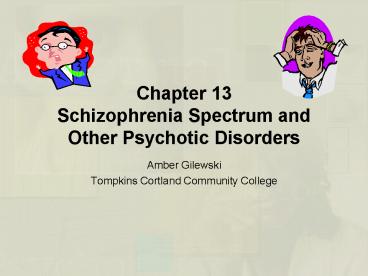Chapter 13 Schizophrenia Spectrum and Other Psychotic Disorders - PowerPoint PPT Presentation
1 / 19
Title:
Chapter 13 Schizophrenia Spectrum and Other Psychotic Disorders
Description:
Chapter 12 Schizophrenia and Other Psychotic Disorders Amber Gilewski Tompkins Cortland Community College * * * * * * * * * * * * The Positive Symptom Cluster ... – PowerPoint PPT presentation
Number of Views:624
Avg rating:3.0/5.0
Title: Chapter 13 Schizophrenia Spectrum and Other Psychotic Disorders
1
Chapter 13Schizophrenia Spectrum and Other
Psychotic Disorders
- Amber Gilewski
- Tompkins Cortland Community College
2
The Positive Symptom Cluster
- The Positive Symptoms
- Active manifestations of abnormal behavior
- Distortions of normal behavior
- Delusions The Basic Feature of Madness
- Gross misrepresentations of reality
- Include delusions of grandeur or persecution
- Hallucinations
- Experience of sensory events without
environmental input - Can involve all senses (auditory most common)
3
The Negative Symptom Cluster
- The Negative Symptoms
- Absence or insufficiency of normal behavior
- Spectrum of Negative Symptoms
- Avolition (or apathy) Lack of initiation and
persistence - Alogia Relative absence of speech
- Anhedonia Lack of pleasure, or indifference
- Affective flattening Little expressed emotion
4
The Disorganized Symptom Cluster
- The Disorganized Symptoms
- Severe and excess speech, behavior, and emotion
- Nature of Disorganized Speech
- Cognitive slippage Illogical and incoherent
speech - Tangentiality Going off on a tangent
- Loose associations Conversation in unrelated
directions - Inappropriate affect -
- Odd emotional behavior
- Disorganized Behavior
- Includes a variety of unusual behaviors
5
Other Disorders with Psychotic Features
Schizophreniform Disorder
- Schizophreniform Disorder
- Schizophrenic symptoms for a few months
- Associated with good premorbid functioning
- Most resume normal lives
- Lifetime prevalence of 0.2
6
Other Disorders with Psychotic Features
Schizoaffective Disorder
- Schizoaffective Disorder
- Symptoms of schizophrenia and a mood disorder
- Both disorders are independent of one another
- Prognosis is similar for people with
schizophrenia - Such persons do not tend to get better on their
own
7
Other Disorders with Psychotic Features
Delusional Disorder
- Delusions that are contrary to reality
- Lack other positive and negative symptoms
- Types of delusions include
- Erotomanic higher status figure love
- Grandiose inflated importance
- Jealous unwarranted beliefs of infidelity
- Persecutory most common conspired against
- Somatic physical defects, disease, disorder
- Extremely rare
- Better prognosis than schizophrenia
8
Additional Disorders with Psychotic Features
Brief Psychotic Disorder
- Brief Psychotic Disorder
- One or more positive symptoms of schizophrenia
- Usually precipitated by extreme stress or trauma
- Tends to remit on its owns
9
Schizophrenia Some Facts and Statistics
- Onset and Prevalence of Schizophrenia worldwide
- About 0.2 to 1.5 (1 population in US)
- Often develops in early adulthood
- Can emerge at any time
- Women have better prognosis
- Schizophrenia Is Generally Chronic
- Life expectancy is slightly less than average
10
Developmental Research
- Brain damage during prenatal or infancy periods
may be a cause of schizophrenia - Early brain abnormality may have better
prognosis due to brains plasticity (ability to
compensate) - Older adults symptoms demonstrate that the
illness may improve over time - Levels of impairment fluctuates between
moderate and severe relapse is common
11
Causes of SchizophreniaFindings From Genetic
Research
- Family Studies
- Inherit a tendency for schizophrenia, not forms
of schizophrenia - Risk increases with genetic relatedness
- Twin Studies
- - Monozygotic twins Risk for
schizophrenia is 48 - - Fraternal (dizygotic) twins Risk drops to 17
- Adoption Studies -- Risk for schizophrenia
remains high
12
Causes of Schizophrenia Neurotransmitter
Influences
- The Dopamine Hypothesis
- Drugs that increase dopamine (agonists)
- Result in schizophrenic-like behavior
- Drugs that decrease dopamine (antagonists)
- Reduce schizophrenic-like behavior
- Neurological damage?
- -Structural and Functional Abnormalities in
the Brain - Enlarged ventricles and reduced tissue volume
13
Location of the cerebrospinal fluid in the human
brain
Fig. 13.7, p. 486
14
Causes of SchizophreniaPsychological and Social
Influences
- The Role of Stress
- May activate underlying vulnerability
- May also increase risk of relapse
- Family Interactions
- Families Show ineffective communication
patterns - High expressed emotion associated
with relapse
15
Medical Treatment of Schizophrenia
- Historical Treatment
- primitive brain surgeries in 1500s
- prefrontal lobotomies used in 1950s
- modern treatment using neuroleptic drugs
www.cerebromente.org.br/n02/historia/psico08.jpg
16
Biological Interventions
- The 1930s
- Insulin coma therapy insulin induced
hypoglycemia resulting in convulsions coma - Psychosurgery disconnecting frontal lobes
- ECT aka shock therapy not beneficial
- The 1950s development of antipsychotic
(neuroleptic) medications - Often the first line treatment for schizophrenia
- Newer medications have fewer serious side effects
www.minddisorders.com/images/gemd_02_img
0087.jpg
17
Medical Treatment of Schizophrenia (continued)
- Compliance with medication is often a problem
(medical relationship, cost, poor supports, side
effects) - Acute and permanent side effects are common
- Akinesia absence, loss, or impairment of the
power of voluntary movement - Tardive dyskinesia
twitching of the face, trunk, or limbs
18
Psychosocial Treatment of Schizophrenia
- Behavioral (i.e., token economies) on inpatient
units - Community care programs outpatient reducing
institutionalization - Social and living skills training teaching
appropriate behaviors - Independent living skills encouraged in
community care programs - Behavioral family therapy helping families to be
more supportive - Vocational rehabilitation aiding in job skills
and employment
19
NAME THAT SYMPTOM!
- Disorder of thought content or delusion
- Delusion of grandeur
- Delusion of persecution
- Auditory hallucination
- Visual hallucination
- Olfactory hallucination
- Tactile hallucination
- Tangentiality
- Loose association
- Waxy flexibility catatonic immobility
- Echopraxia
- Echolalia
- Alogia
- Disorganized behavior






















![Introduction to Biopsychology [PSB 4002] PowerPoint PPT Presentation](https://s3.amazonaws.com/images.powershow.com/6377876.th0.jpg?_=20150404023)








